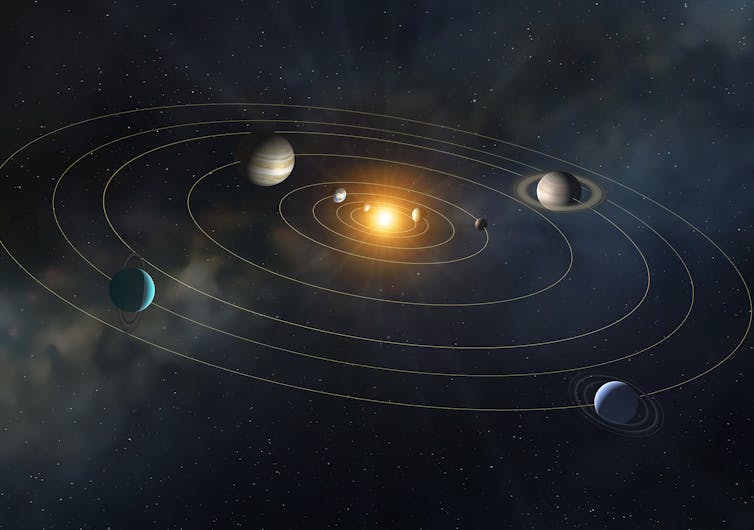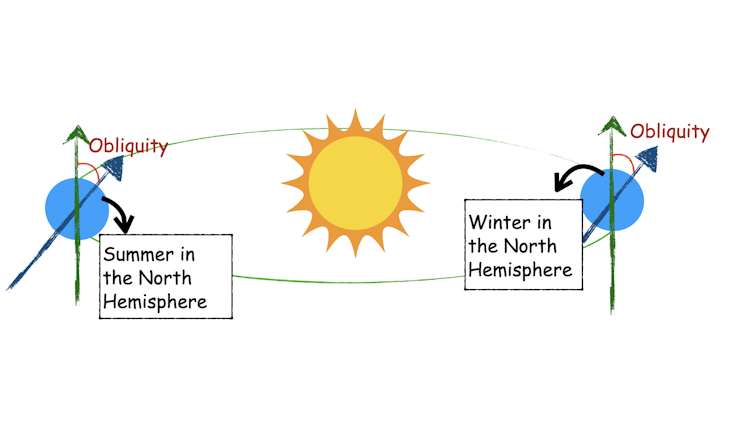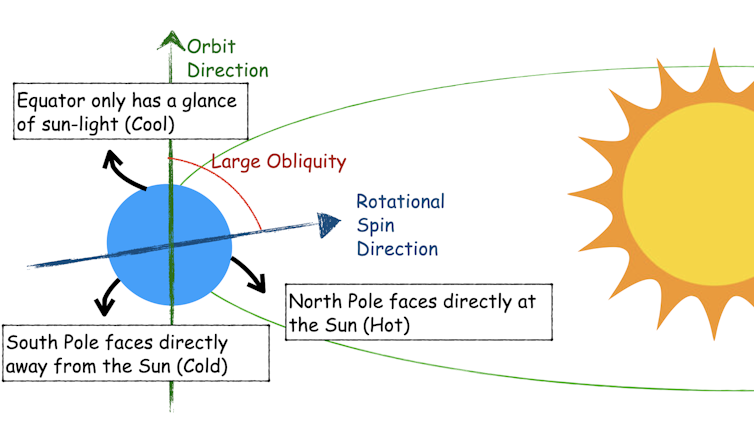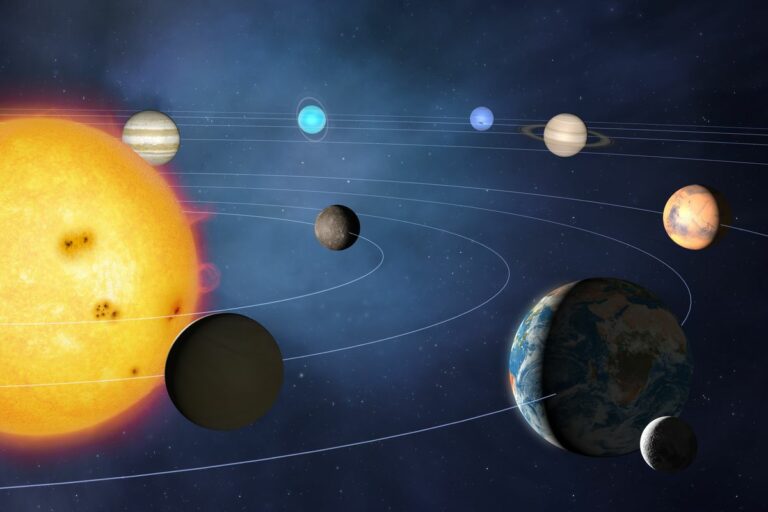Earth isn’t the only planet with seasons, but they can look wildly different on other worlds

Spring, summer, fall and winter – the seasons on Earth change every few months, around the same time every year. It’s easy to take this cycle for granted here on Earth, but not every planet has a regular change in seasons. So why does Earth have regular seasons when other planets don’t?
I’m an astrophysicist who studies the movement of planets and the causes of seasons. Throughout my research, I’ve found that Earth’s regular pattern of seasons is unique. The rotational axis that Earth spins on, along the North and South poles, isn’t quite aligned with the vertical axis perpendicular to Earth’s orbit around the Sun.
That slight tilt has big implications for everything from seasons to glacier cycles. The magnitude of that tilt can even determine whether a planet is habitable to life.
Seasons on Earth
When a planet has perfect alignment between the axis it orbits on and the rotational axis, the amount of sunlight it receives is fixed as it orbits around the Sun – assuming its orbital shape is a circle. Since seasons come from variations in how much sunlight reaches the planet’s surface, a planet that’s perfectly aligned wouldn’t have seasons. But Earth isn’t perfectly aligned on its axis.
This small misalignment, called an obliquity, is around 23 degrees from vertical for Earth. So, the Northern Hemisphere experiences more intense sunlight during the summer, when the Sun is positioned more directly above the Northern Hemisphere.
Then, as the Earth continues to orbit around the Sun, the amount of sunlight the Northern Hemisphere receives gradually decreases as the Northern Hemisphere tilts away from the Sun. This causes winter.

The planets spinning on their axes and orbiting around the Sun look kind of like spinning tops – they spin around and wobble because of gravitational pull from the Sun. As a top spins, you might notice that it doesn’t just stay perfectly upright and stationary. Instead, it may start to tilt or wobble slightly. This tilt is what astrophysicists call spin precession.
Because of these wobbles, Earth’s obliquity isn’t perfectly fixed. These small variations in tilt can have big effects on the Earth’s climate when combined with small changes to Earth’s orbit shape.
The wobbling tilt and any natural variations to the shape of Earth’s orbit can change the amount and distribution of sunlight reaching Earth. These small changes contribute to the planet’s larger temperature shifts over thousands to hundreds of thousands of years. This can, in turn, drive ice ages and periods of warmth.
Translating obliquity into seasons
So how do obliquity variations affect the seasons on a planet? Low obliquity, meaning the rotational spin axis is aligned with the planet’s orientation as it orbits around the Sun, leads to stronger sunlight on the equator and low sunlight near the pole, like on Earth.
On the other hand, a high obliquity – meaning the planet’s rotational spin axis points toward or away from the Sun – leads to extremely hot or cold poles. At the same time, the equator gets cold, as the Sun does not shine above the equator all year round. This leads to drastically varying seasons at high latitudes and low temperatures at the equator.

When a planet has an obliquity of more than 54 degrees, that planet’s equator grows icy and the pole becomes warm. This is called a reversed zonation, and it’s the opposite of what Earth has.
Basically, if an obliquity has large and unpredictable variations, the seasonal variations on the planet become wild and hard to predict. A dramatic, large obliquity variation can turn the whole planet into a snowball, where it’s all covered by ice.
Spin orbit resonances
Most planets are not the only planets in their solar systems. Their planetary siblings can disturb each other’s orbit, which can lead to variations in the shape of their orbits and their orbital tilt.
So, planets in orbit look kind of like tops spinning on the roof of a car that’s bumping down the road, where the car represents the orbital plane. When the rate – or frequency, as scientists call it – at which the tops are precessing, or spinning, matches the frequency at which the car is bumping up and down, something called a spin-orbit resonance occurs.

Spin-orbit resonances can cause these obliquity variations, which is when a planet wobbles on its axis. Think about pushing a kid on a swing. When you push at just the right time – or at the resonant frequency – they’ll swing higher and higher.
Mars wobbles more on its axis than Earth does, even though the two are tilted about the same amount, and that actually has to do with the Moon orbiting around Earth. Earth and Mars have a similar spin precession frequency, which matches the orbital oscillation – the ingredients for a spin-orbit resonance.
But Earth has a massive Moon, which pulls on Earth’s spin axis and drives it to precess faster. This slightly faster precession prevents it from experiencing spin orbit resonances. So, the Moon stabilizes Earth’s obliquity, and Earth doesn’t wobble on its axis as much as Mars does.
Exoplanet seasons
Thousands of exoplanets, or planets outside our solar system, have been discovered over the past few decades. My research group wanted to understand how habitable these planets are, and whether these exoplanets also have wild obliquities, or whether they have moons to stabilize them like Earth does.
To investigate this, my group has led the first investigation on the spin-axis variations of exoplanets.
We investigated Kepler-186f, which is the first discovered Earth-sized planet in a habitable zone. The habitable zone is an area around a star where liquid water can exist on the surface of the planet and life may be able to emerge and thrive.
Unlike Earth, Kepler-186f is located far from the other planets in its solar system. As a result, these other planets have only a weak effect on its orbit and movement. So, Kepler-186f generally has a fixed obliquity, similar to Earth. Even without a large moon, it doesn’t have wildly changing or unpredictable seasons like Mars.
Looking forward, more research into exoplanets will help scientists understand what seasons look like throughout the vast diversity of planets in the universe.![]()
Gongjie Li, Assistant Professor of Physics, Georgia Institute of Technology
This article is republished from The Conversation under a Creative Commons license. Read the original article.
Do not forget to share your opinion with us to provide you with the best posts !




0 Comments